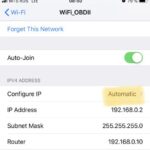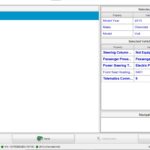OBD2 code P0420 indicates a problem with your vehicle’s catalytic converter. Specifically, it means the catalyst system efficiency is below the required threshold for Bank 1. This article will help you understand what this code means, its potential causes, symptoms, and how to diagnose and fix the issue.
What Does OBD2 Code P0420 Mean?
Your car’s catalytic converter is part of the exhaust system and responsible for converting harmful pollutants into less harmful substances. The engine control module (ECM) monitors the efficiency of the catalytic converter using oxygen sensors placed before and after it. When the downstream oxygen sensor readings mirror the upstream sensor readings, it suggests the catalytic converter isn’t working efficiently enough to reduce emissions. “Bank 1” refers to the side of the engine that contains cylinder #1.
Causes of OBD2 Code P0420
Several issues can trigger a P0420 code:
- Faulty Catalytic Converter: The most common cause is a damaged or worn-out catalytic converter. Over time, the internal honeycomb structure can become contaminated or break down, reducing its efficiency.
- Damaged Oxygen Sensors: A malfunctioning oxygen sensor (especially the downstream sensor) can provide inaccurate readings to the ECM, triggering the code even if the catalytic converter is working correctly.
- Exhaust Leaks: Leaks in the exhaust system before or after the catalytic converter can disrupt exhaust flow and affect oxygen sensor readings. This can fool the ECM into thinking the catalytic converter is faulty.
- Engine Misfires: Misfires cause unburned fuel to enter the exhaust system, overheating the catalytic converter and potentially damaging it.
- Rich Fuel Mixture: An overly rich air-fuel mixture can also damage the catalytic converter due to excessive heat.
- Faulty Engine Coolant Temperature Sensor: An incorrect engine temperature reading can affect fuel mixture calculations, leading to a rich mixture and potential catalytic converter damage.
Symptoms of OBD2 Code P0420
While the check engine light illuminating is the primary indicator, other symptoms may include:
- Decreased Fuel Economy: A less efficient catalytic converter can lead to worse gas mileage.
- Loss of Power: In severe cases, a clogged converter can restrict exhaust flow, reducing engine performance.
- Rotten Egg Smell: A sulfurous odor from the exhaust can indicate a malfunctioning catalytic converter.
- Failed Emissions Test: Your vehicle will likely fail an emissions test with a P0420 code present.
Diagnosing OBD2 Code P0420
Proper diagnosis is crucial to avoid unnecessary repairs. Here are some steps:
- Scan for Codes: Use an OBD2 scanner to verify the P0420 code and check for any other related codes.
- Inspect Exhaust System: Visually check for leaks, damage, or restrictions in the exhaust system.
- Test Oxygen Sensors: Use a multimeter or scan tool to check the voltage readings of the oxygen sensors.
- Monitor Sensor Data: Use a scan tool to observe the live data from the oxygen sensors while the engine is running. Compare the upstream and downstream sensor readings.
- Check for Engine Misfires: Diagnose and repair any engine misfire codes before addressing the P0420.
Fixing OBD2 Code P0420
Repairing the underlying issue is the only way to resolve a P0420 code. Common solutions include:
- Replace Catalytic Converter: If confirmed faulty, the catalytic converter needs replacement.
- Replace Oxygen Sensor(s): Replace faulty oxygen sensors with OEM or high-quality aftermarket parts.
- Repair Exhaust Leaks: Fix any exhaust leaks to ensure proper exhaust flow.
- Address Engine Misfires: Diagnose and repair any engine misfires.
- Correct Fuel Mixture Issues: Address any issues causing a rich fuel mixture, such as faulty fuel injectors or a malfunctioning mass airflow sensor.
Conclusion
The OBD2 code P0420 indicates a potential problem with your vehicle’s catalytic converter or related components. Accurate diagnosis is essential to ensure the correct repairs are made. While a DIY approach is possible for some diagnostic steps, more complex repairs may require professional assistance. Addressing the issue promptly can prevent further damage to your vehicle and help ensure it passes emissions testing.

